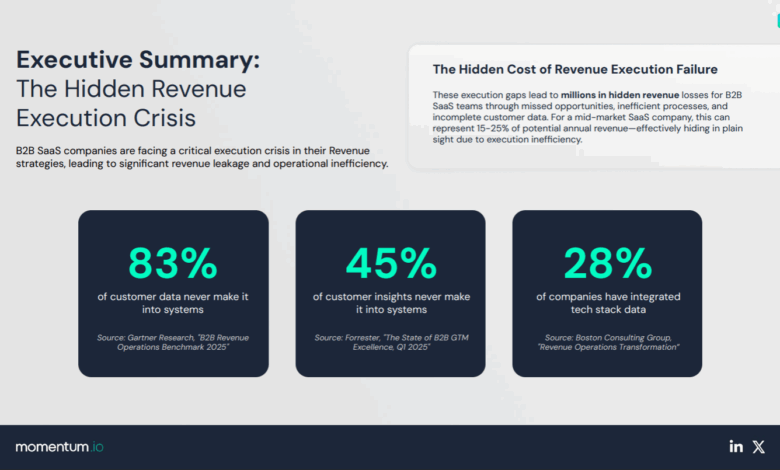
For years, AI has been pitched as the ultimate solution for business transformation. Yet many CEOs and revenue leaders find themselves grappling with a disconnect between AI’s promise and its tangible impact on their bottom line. While traditional AI has delivered incremental improvements in specific tasks, it often falls short of providing the strategic execution demanded by C-suite and GTM teams.
Today’s CEOs and revenue leaders are under immense pressure to maximize growth and operational agility with lean resources. While traditional AI co-pilot tools that transcribe, summarize, and suggest actions promise efficiency, they are falling significantly short of precisely where it matters most: execution.
The Hidden Execution Crisis
It’s true that the most important information and data is held in the interactions and conversations that you have with prospects and customers every day.
According to Gartner’s 2025 B2B Revenue Operations Benchmark, 83% of customer data never makes it into critical systems, creating substantial gaps in actionable insights. This isn’t unique. In The State of B2B GTM Excellence by Forrester, 45% of customer insights vanish before they reach internal teams. This fragmentation translates directly into missed revenue opportunities, inaccurate forecasting, and poor strategic decision-making, costing mid-market SaaS businesses up to 15-25% of their annual potential revenue.
Beyond these stark statistics, Boston Consulting Group found that only 28% of companies have integrated tech stack data, compounding the problem by leaving critical customer information stranded in silos, with no action resulting from it. Without comprehensive data integration, executives cannot reliably make data-driven decisions, leading to systemic inefficiencies and lost opportunities.
Where Traditional AI and Conversation Intelligence Misses the Mark
Traditional co-pilot AI and conversation intelligence technologies primarily provides visibility through dashboards, transcripts, and summaries, but it stops short of actual execution. It places the burden of action squarely on already overstretched teams, exacerbating an existing crisis of administrative overload.
Gartner’s 2025 Sales Productivity in the Digital Era report reveals that sales representatives spend approximately 45% of their time on non-revenue-generating tasks such as manual CRM updates, note-taking, and follow-up emails. This monotonous burden stifles productivity and contributes to employee burnout and turnover, undermining team stability and performance.
Additionally, the reliance on manual data entry inherently leads to human errors, resulting in inconsistent and inaccurate CRM records. Poor data quality undermines forecasting accuracy and strategic decision-making, further distancing organizations from their revenue targets.
So, what’s the solution? Enter Agentic AI, a shift that is redefining how businesses operate and expand at scale. It aligns directly with the growing executive demand for real-time adaptability and revenue-driving results.
The Rise of Agentic AI
Representing a profound shift beyond mere insights, agentic AI is different: actively executing tasks, triggering necessary updates, and sending real-time alerts directly within existing workflows. Deloitte predicts that 25% of companies will pilot agentic AI this year alone, with adoption expected to double by 2027. This will be driven by an escalating demand from executives for operational agility and efficiency.
Unlike traditional AI, agentic systems continuously capture structured, first-party data directly from customer interactions and automatically route critical insights to relevant teams without manual intervention. This capability fundamentally alters how teams interact and leverage data, transforming passive data repositories into dynamic, actionable information streams that prompt immediate response.
The key to all of this is working with Agentic AI that is secure with SOCII and GDPR compliance, data is safe with Zero retention policies with the LLM providers, and the outputs of the AI can be trusted to be clean and accurate.
Real-time Orchestration and Automation
Agentic AI’s strength is its seamless integration within existing technology ecosystems, such as CRM and communication platforms, eliminating cumbersome manual processes. It captures critical customer and market signals, from pricing discussions and competitive mentions to shifts in customer sentiment and early churn indicators. It automatically translates them into actions like CRM field updates, alerts to customer success teams, and proactive risk mitigation efforts.
Organizations that leverage these capabilities experience major performance improvements. Gartner indicates that effective signal capturing and immediate action can improve win rates by 23% and shorten sales cycles by approximately 14 days. Additionally, early risk detection capabilities can lead to a 23% reduction in customer churn, as validated by the Boston Consulting Group’s 2024 Revenue Execution Benchmark.
The Operational Agility Imperative
Within today’s hyper-competitive GTM strategies, operational agility is not merely advantageous; it’s essential. CEOs and revenue leaders must urgently adapt to shifting market dynamics, emerging competition, and evolving customer expectations. Agentic AI enables this agility by automating the capture, structuring, and dissemination of crucial insights and actions in real time, effectively transitioning revenue strategies from reactive to proactive. This proactive approach ensures that critical opportunities are identified and immediately acted upon, enhancing organizational responsiveness and strategic effectiveness.
The Future is Agentic: Transforming Team Dynamics
Agentic AI is not about replacing people but empowering them. By automating repetitive, low-value tasks, teams can refocus their attention and creativity on high-value, strategic activities. This shift enhances productivity and improves employee satisfaction, engagement, and retention. The human workforce thus becomes more strategic, operating at peak effectiveness rather than being bogged down in administrative minutiae.
As executive expectations evolve, passive AI solutions will fail to meet organizational needs. Leaders now demand tools that deliver instant, actionable outcomes. Agentic AI embodies this new era of operational intelligence, going beyond mere workflow enhancement to fundamentally transform revenue team operations, execution, and result delivery.
For organizations committed to sustained growth and competitive advantage, embracing agentic AI is not a future aspiration but an immediate operational necessity. Transitioning from co-pilot to autopilot ensures companies capture and fully capitalize on the revenue currently lost through execution gaps, ultimately realizing their full strategic potential.





